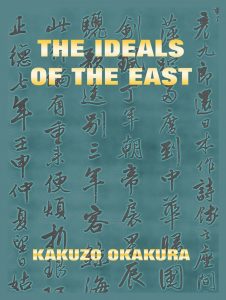The Ideals Of The East – Kakuzo Okakura
The results of Mr. Okakura’s visits to China and India, where he made exhaustive studies, are brilliantly set forth in this book, ” The Ideals of the East “, explaining his important and now generally accepted analysis of the movements of thought and art throughout Asia.
Format: Paperback.
The Ideals Of The East.
ISBN: 9783849672249.
Available at amazon.com and other venues.
Biography of Kakuzo Okakura (from wikipedia.com)
Born in Yokohama to parents originally from Fukui, Okakura learned English while attending a school operated by Christian missionary, Dr. Curtis Hepburn. At 15, he entered Tokyo Imperial University, where he first met and studied under Harvard-educated professor Ernest Fenollosa. In 1889, Okakura co-founded the periodical Kokka. In 1887 he was one of the principal founders of the Tokyo School of Fine Arts (東京美術学校 Tōkyō Bijutsu Gakkō), and a year later became its head, although he was later ousted from the school in an administrative struggle. Later, he also founded the Japan Art Institute with Hashimoto Gahō and Yokoyama Taikan. He was invited by William Sturgis Bigelow to the Museum of Fine Arts, Boston in 1904 and became the first head of the Asian art division in 1910.
Okakura was a high-profile urbanite who had an international sense of self. In the Meiji period he was the first dean of the Tokyo Fine Arts School (later merged with the Tokyo Music School to form the current Tokyo University of the Arts). He wrote all of his main works in English. Okakura researched Japan’s traditional art and traveled to Europe, the United States, China and India. He emphasised the importance to the modern world of Asian culture, attempting to bring its influence to realms of art and literature that, in his day, were largely dominated by Western culture.
His 1903 book on Asian artistic and cultural history, The Ideals of the East with Special Reference to the Art of Japan, published on the eve of the Russo-Japanese War, is famous for its opening paragraph in which he sees a spiritual unity throughout Asia, which distinguishes it from the West:
Asia is one. The Himalayas divide, only to accentuate, two mighty civilisations, the Chinese with its communism of Confucius, and the Indian with its individualism of the Vedas. But not even the snowy barriers can interrupt for one moment that broad expanse of love for the Ultimate and Universal, which is the common thought-inheritance of every Asiatic race, enabling them to produce all the great religions of the world, and distinguishing them from those maritime peoples of the Mediterranean and the Baltic, who love to dwell on the Particular, and to search out the means, not the end, of life.
In his subsequent book, The Awakening of Japan, published in 1904, he argued that “the glory of the West is the humiliation of Asia.” This was an early expression of Pan-Asianism. In this book Okakura also noted that Japan’s rapid modernization was not universally applauded in Asia: ″We have become so eager to identify ourselves with European civilization instead of Asiatic that our continental neighbors regard us as renegades—nay, even as an embodiment of the White Disaster itself.”
In his The Book of Tea, which was written in English in 1906, he states:
It (Teaism) insulates purity and harmony, the mystery of mutual charity, the romanticism of the social order. It is essentially a worship of the Imperfect, as it is a tender attempt to accomplish something possible in this impossible thing we know as life.
In Japan, Okakura, along with Fenollosa, is credited with “saving” Nihonga, or painting done with traditional Japanese technique, as it was threatened with replacement by Western-style painting, or “Yōga”, whose chief advocate was artist Kuroda Seiki. In fact this role, most assiduously pressed after Okakura’s death by his followers, is not taken seriously by art scholars today, nor is the idea that oil painting posed any serious “threat” to traditional Japanese painting. Yet Okakura was certainly instrumental in modernizing Japanese aesthetics, having recognized the need to preserve Japan’s cultural heritage, and thus was one of the major reformers during Japan’s period of modernization beginning with the Meiji Restoration.
Outside Japan, Okakura influenced a number of important figures, directly or indirectly, who include Swami Vivekananda, philosopher Martin Heidegger, poet Ezra Pound, and especially poet Rabindranath Tagore and heiress Isabella Stewart Gardner, who were close personal friends of his.
(The text of the last section was taken from a Wikipedia entry and is available under the the Creative Commons Attribution-ShareAlike License.)
Publisher’s Note: This book is printed and distributed by Createspace a DBA of On-Demand Publishing LLC and is typically not available anywhere else than in stores owned and operated by Amazon or Createspace.

